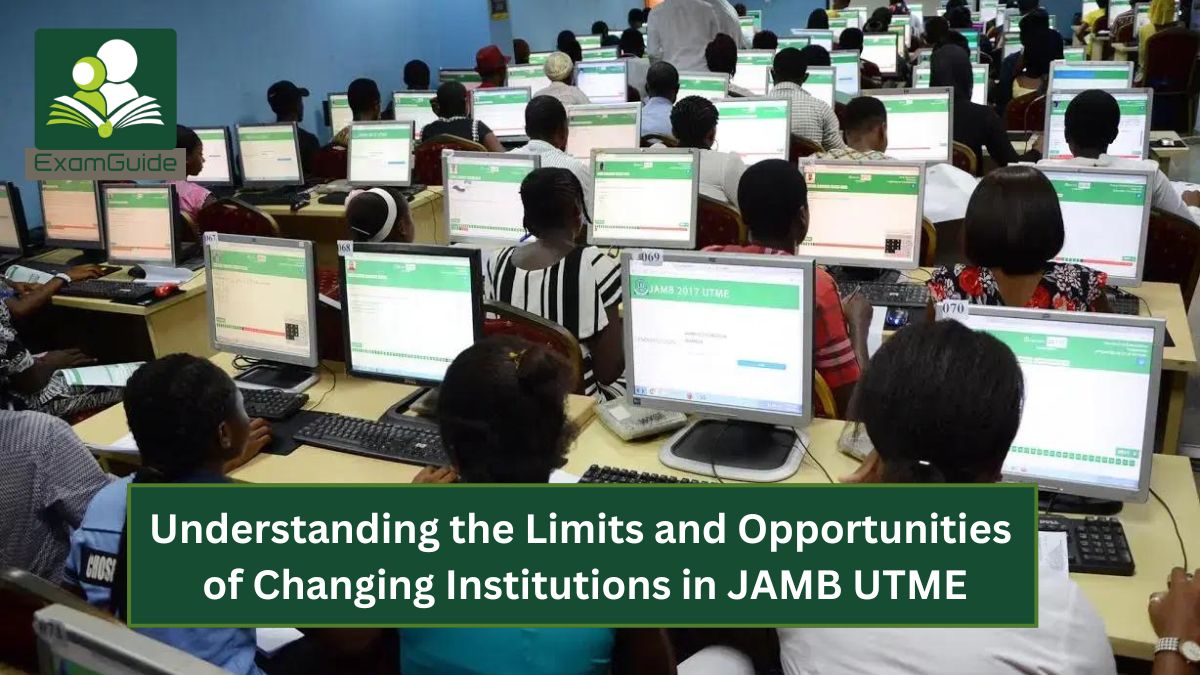
Understanding the Limits and Opportunities of Changing Institutions in JAMB UTME
The Joint Admissions and Matriculation Board (JAMB) has introduced a new policy that allows Unified Tertiary Matriculation Examination (UTME) candidates to change their choice of tertiary institution multiple times.
This development is a significant shift from previous policies, which restricted the number of changes a candidate could make.
This article explores the implications of this policy, analyzing its potential benefits and challenges for students, universities, and the overall admissions process.
Table of Content
JAMB Reveals How Many Times UTME Candidates Can Change Institutions in 2024
What Opportunities Does This Policy Offer to Students?
What Challenges Might Arise from This Policy?
How Can the New Policy Be Optimized?
JAMB Reveals How Many Times UTME Candidates Can Change Institutions in 2024
JAMB has officially announced that UTME candidates can now change their choice of tertiary institution as many times as they desire. This flexibility is available as long as the institution's portal remains open for the admission process.
The Nigerian examination board shared this information on its X (formerly Twitter) handle, @JAMBHQ, emphasizing that the change of institution is unrestricted while the target school is still accepting applications.
Key Points to Note
- No Change Limit: Contrary to some reports, JAMB has confirmed that candidates are free to change their institution as many times as they wish. This flexibility is aimed at ensuring that candidates can make the best possible decisions for their academic future.
- Use the Official Portal: All changes should still be made through the official JAMB e-Facility portal. Avoid using any unofficial platforms to prevent errors in your application.
- Standard Fees Apply: While there is no limit on changes, candidates will still need to pay the required fee for each change they make.
This update is a relief for many candidates who might be reconsidering their choices. It allows for greater flexibility in aligning academic goals with the right institution or course.
What Opportunities Does This Policy Offer to Students?
This new policy opens up several opportunities for students and educational institutions alike.
Increased Flexibility for Students
The ability to change institutions multiple times provides students with greater flexibility in making decisions about their academic futures.
If a student's initial choice does not align with their career goals or personal circumstances, they now have the freedom to reconsider and select a more suitable institution without the fear of being locked into a single choice.
Reduced Pressure on Students
In previous years, the decision of choosing a tertiary institution was a high-stakes one, often made under pressure. This new policy alleviates some of that pressure, allowing students to make changes if they feel they made an error or if better opportunities arise.
Enhanced Competition Among Universities
With students having the option to switch institutions freely, universities may face increased competition to attract and retain students. This could lead to improvements in academic programs, facilities, and student support services as institutions strive to become more appealing to prospective students.
What Challenges Might Arise from This Policy?
While the policy offers numerous benefits, it also presents several challenges that need to be addressed.
Administrative Burden on JAMB and Universities
The ability to change institutions multiple times could lead to a significant increase in administrative tasks for JAMB and universities. Processing these changes, updating records, and ensuring accuracy could strain resources and potentially delay other critical processes.
Risk of System Abuse
There is a possibility that some students might abuse the system by making multiple changes without serious intent. This could result in unnecessary complications, such as holding spots at multiple institutions and disrupting the admissions process for other candidates.
Impact on Course Placement and Admission Targets
Frequent changes in institution choice could affect course placement and adherence to admission targets. Universities may find it challenging to maintain balanced enrollments across programs, potentially leading to overcrowded courses or under-enrolled programs.
How Can the New Policy Be Optimized?
To optimize the benefits of this new policy while reducing its challenges, several measures should be considered:
- Proper Counseling and Guidance: It is crucial that students receive adequate counselling and guidance to make informed decisions about changing institutions. Educational institutions and JAMB should collaborate to provide resources that help students understand the implications of their choices.
- Clear Guidelines and Monitoring: JAMB should establish clear guidelines to prevent abuse of the system. Monitoring mechanisms can be put in place to track changes and ensure that students are making thoughtful decisions rather than impulsive ones.
- Universities Should Enhance Offerings: Universities need to recognize the increased competition and focus on improving their academic and extracurricular offerings. By creating a more attractive environment, institutions can not only attract but also retain students who might otherwise consider changing schools.
Frequently Asked Questions
Will changing my institution affect my admission chances?
While changing your institution might not directly affect your admission chances, it could impact your preferred course and department. Some institutions might have specific cut-off points.
Can I change my institution after I have been admitted?
You cannot change your institution after you have been admitted. The option to change is usually available before the admission process begins.
How do I change my institution on JAMB?
To change your institution on JAMB, you must use the official JAMB e-Facility portal. Avoid using any unofficial platforms to prevent errors.
Is there a limit to the number of times I can change my institution on JAMB?
No, there is no limit to the number of times you can change your institution on JAMB. Candidates are free to change their preferred institution as many times as they wish before the closing date.
Are there any fees associated with changing my institution on JAMB?
Yes, there is a fee associated with changing your institution on JAMB. Candidates will be required to pay the stipulated fee for each change made.
What should I do if I encounter issues while changing my institution on the JAMB portal?
If you encounter any issues while changing your institution on the JAMB portal, it is advisable to contact the JAMB helpdesk for assistance.
Conclusion
The new JAMB policy allowing multiple changes of institution presents both opportunities and challenges. While it offers greater flexibility and reduces the pressure on students, it also raises concerns about administrative burdens and potential system abuse.
As this policy is implemented, all stakeholders need to approach it with careful consideration, ensuring that the ultimate goal of improving student outcomes is achieved.
Students, in particular, should be mindful of the long-term implications of changing institutions and strive to make decisions that align with their academic and career aspirations.
No comment found
Related Posts
JAMB CBT SOFTWARE

Key Differences Between JAMB and Post-UTME Exams

JAMB Cut-Off Mark for Nursing 2025: All You Need to Know

How to Access JAMB Inter-Programme Transfer, Deletion, and Results Certificate Upload Services | Portal Activated

2025 Lists of All JAMB Accredited Professional Testing Centres (PTC) and Professional Registration Centres (PRC) in Nigeria.


